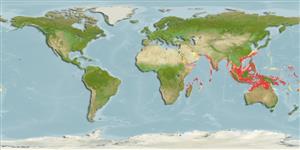Common names from other countries
Environment: milieu / climate zone / depth range / distribution range
Ecologie
marien rifbewoner; diepte 20 - 200 m (Ref. 11441). Tropical; 30°N - 19°S
Indo-West Pacific: Persian Gulf to the western coast of India, eastward to the Pacific, where it occurs from Taiwan southward to the Arafura Sea (Ref. 9819) and northern Queensland, Australia (Ref. 3414).
Lengte bij maturiteit / Grootte / Gewicht / Leeftijd
Maturity: Lm 21.1 range ? - ? cm
Max length : 35.0 cm TL mannelijk / geslacht onbekend; (Ref. 11441); common length : 25.0 cm TL mannelijk / geslacht onbekend; (Ref. 3483)
Inhabits coral or rocky areas. Sometimes forms aggregations. Feeds on a wide variety of benthic animals. Smaller fish are mostly found inshore. Marketed mostly fresh, whole or dried-salted.
Levenscyclus en paargedrag
Maturities | Voortplanting | Spawnings | Egg(s) | Fecundities | Larven
Starnes, W.C., 1988. Revision, phylogeny and biogeographic comments on the circumtropical marine percoid fish family Priacanthidae. Bull. Mar. Sci. 43(2):117-203. (Ref. 5403)
Status op de Rode Lijst van het IUCN (Ref. 130435)
CITES (Ref. 128078)
Not Evaluated
Gevaar voor de mens
Harmless
Gebruik door de mens
Visserij: van minder commercieel belang
Tools
Speciale rapporten
Download XML
Internetbronnen
Estimates based on models
Preferred temperature (Ref.
115969): 21.9 - 28.3, mean 26.8 (based on 847 cells).
Fylogenetische diversiteitsindex (Ref.
82804): PD
50 = 0.5002 [Uniqueness, from 0.5 = low to 2.0 = high].
Bayesian length-weight: a=0.02138 (0.01571 - 0.02910), b=2.90 (2.82 - 2.98), in cm Total Length, based on LWR estimates for this species (Ref.
93245).
Trofisch niveau (Ref.
69278): 3.8 ±0.3 se; based on diet studies.
Weerstandsvermogen (Ref.
120179): Hoog, minimale populatieverdubbelingstijd minder dan 15 maanden (K=0.6-1.23).
Fishing Vulnerability (Ref.
59153): Low vulnerability (23 of 100).
